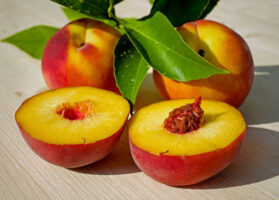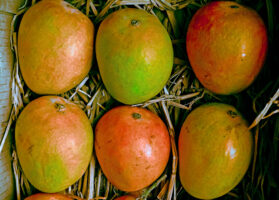Polish Blueberry Market: Navigating Frost, Varietal Shifts, and Workforce Challenges in 2024

In this installment of the ‘Agronometrics In Interviews’ series, Agronometrics studies the state of the Polish blueberry season in an exclusive interview with Sandra Stefaniak-Syguła, co-owner of Berry Trade. The series is based on interviews with esteemed professionals from the industry, focusing on a specific origin or topic visualizing the market factors that are driving change.

Sandra Stefaniak-Syguła, co-owner of Berry Trade.
How many hectares should enter into production this season?
The speed of planting has significantly slowed down compared to pre-COVID times. In discussions with some industry experts, they mentioned that the focus is now more on replacing varieties rather than planting new ones.
Growers are interested in trying out new varieties, particularly those suited for high chill and our climate, but they are cautious. They aren’t planting tens or hundreds of hectares at once. Instead, they might try a few hectares first to see how the variety performs. So, while the number of hectares is increasing, this growth is relatively small compared to previous years.
Is there any particular variety that is receiving special interest in Poland at the moment?
According to the growers we cooperate with, the varieties Calypso, Cargo, Titanium, and MegasBlue are receiving quite positive comments. Some growers are also experimenting with Valor, whose fruit is particularly impressive in terms of size.
The situation with late varieties is controversial. In some years, like last year and possibly this year again, growers with late varieties may be pleased with their prices. However, in other years, such as 2021 and 2022, Poland was pushed out of the market when large quantities of Peruvian blueberries arrived in Europe. Even though Polish blueberries were much cheaper, supermarkets preferred to switch to Peruvian supply. This makes growers wary of committing to late-season varieties despite the potential market opportunities.
United Kingdom Fresh Import Volume By Partner | Cultivated Conventional
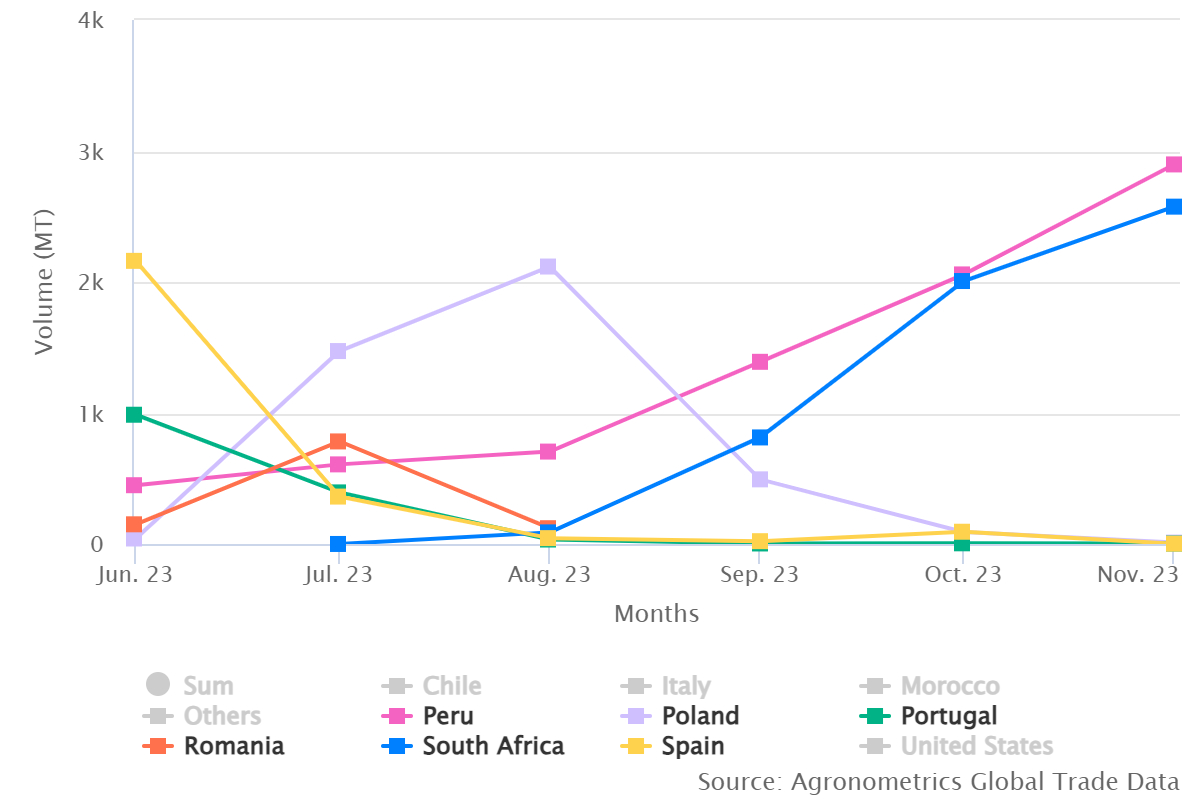
What is the production forecast for this 2024 season?
It’s a bit hard to answer right now because we haven’t received any kilograms of the Polish crop yet (Ed. Note. As of June 21, 2024). The growers who have started picking are placing their first harvested fruits on the local market. In the first days of the season of the season, the Polish market pays higher prices than the export market. The last volumes from Serbia and Romania are still available but they are already done with their peak volumes, so we are actually starting at a good moment.
On the export market, there is significant competition, especially since we sell the majority of our volumes to the German market. Our main competitors there are the German growers themselves. However, German buyers continue to work with Polish suppliers to ensure fully stocked shelves once German growers stop picking or their volumes decrease.
We are about to start picking, likely today (Ed. Note. As of June 21, 2024) or tomorrow, and we expect the first trucks of Polish bulk blueberries to enter our facility and start packing. The season has started two to three weeks earlier than last year for some growers.
Our industry expects the peak of Polish blueberries around July 20th. The timing will largely depend on the weather. Unlike growers in Peru who can use pruning and other techniques to control the timing of their harvest, we are entirely dependent on nature and temperature. If the current high temperatures persist, the main volumes will likely be ready in July. However, if the nights become colder or we experience some cooler days, the timing could change again.
What have been the challenges of this 2024 season so far?
In terms of challenges this year, I can mention that frost had an impact, especially on the Duke variety, which is the first to blossom. If it weren’t for the freeze, we might already be in full picking mode. The flowers started blooming very early this year, and the freeze affected these first open flowers.
As a result, the Duke variety will have a reduced yield, around 20-30% less than what we would have if it weren’t for the frost.
When the large-scale plantings occurred in Poland a few years ago, many growers chose Duke because it typically offers a good return early in the season, workers are available, and it’s a good variety for our climate. Consequently, we’ve usually seen two peaks in production: one for Duke and another for Bluecrop, the most frequently planted variety in Poland. Given the frost damage to Duke, it appears that this year’s major peak will be with the Bluecrop variety.
Another major issue that is highly relevant for blueberry growers is the workforce. In Poland, the majority of pickers come from Ukraine. However, by September, it becomes incredibly difficult to find workers. One reason, according to growers, is that apple picking begins around this time, and pickers prefer to switch tasks, likely wanting a change after weeks of picking blueberries.
Another factor is that many of these pickers, who are mostly women, return home around the first days of September when the school year starts in both Poland and Ukraine.
The war in Ukraine has further complicated the workforce situation. Since the war began, there have been more women from Ukraine than men, which has changed the dynamics. Men are typically the truck drivers, so there’s now a shortage of drivers. For tasks that require more physical strength, we have had to rely on strong women, but finding the right employees for certain roles remains difficult.
Because of these challenges, growers are more inclined to plant early varieties like Duke or replace the middle-season Bluecrop, which is currently the most popular in Poland, with varieties like Calypso. They are generally hesitant to plant late varieties due to the labor shortages later in the season.
Germany and the UK have historically been by far the main importers of Polish blueberries. How do you see that evolving and are there any other secondary market that you think might be growing in the coming years?
Yes, the largest volumes definitely need to be placed in the UK and Germany. When it comes to volume, the most relevant competing market is the Polish market. Last year, we observed that the prices paid by Polish supermarkets were really competitive compared to previous years. Domestic demand and general consumption are growing.
This is quite favorable, especially for growers who sometimes prefer the local market because it may pay a bit less than export but involves less risk, fewer quality maintenance issues, and perhaps fewer required certificates. This option can be more attractive during certain times of the season when domestic prices are strong.
We are also working on developing air shipments to the Middle East and Far East. The Polish blueberry industry hasn’t focused much on these regions, although some companies have been active in this field. In my opinion, there is still much potential here.We have excellent production and packing facilities, advanced machinery, and convenient access to airports, and there is strong interest from customers. However, sometimes minor yet critical elements, such as the right packing materials, are missing and need to be imported from places like Southern Spain. This is an area we’re focusing on improving.
Fresh Export Volumes From Poland | Cultivated All
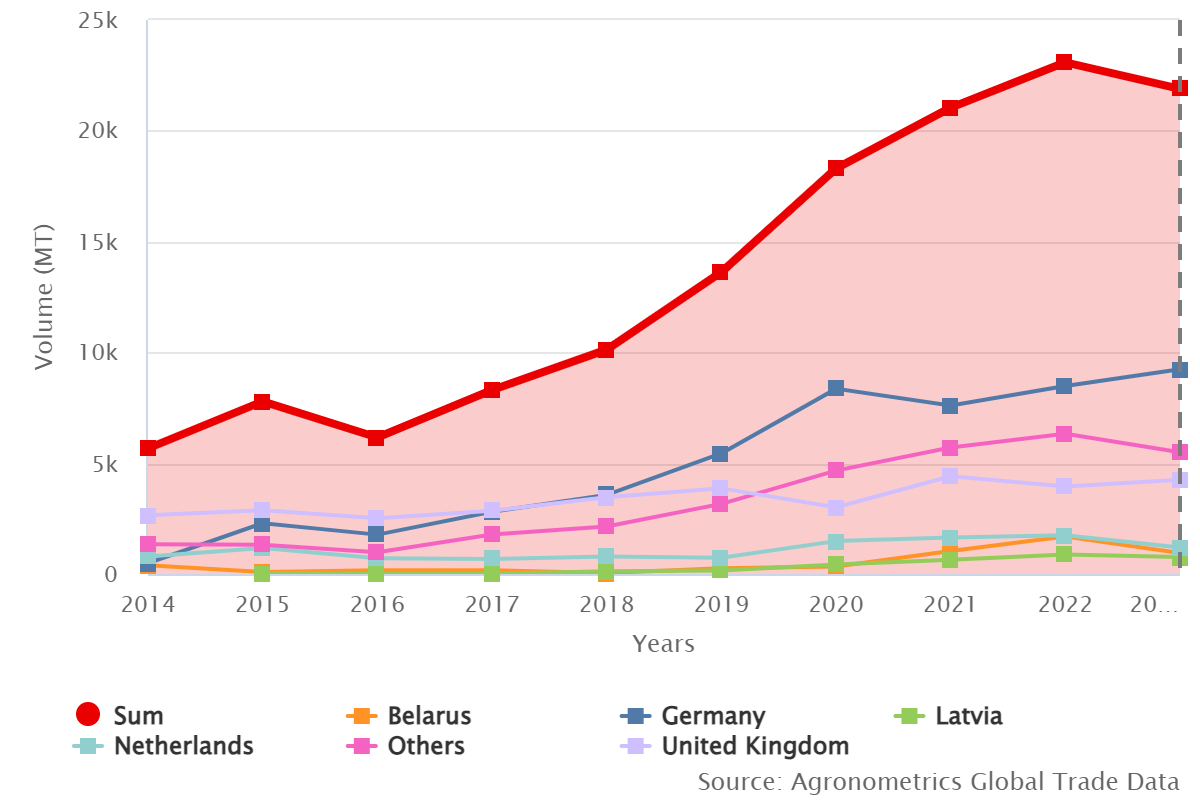
In terms of pricing, prices in Germany might sometimes be lower than in the UAE. However, the comparison isn’t entirely straightforward. For the German market, the typical packaging unit during that period is usually 500 grams. In contrast, when shipping by air to the Middle East, the packaging is normally 125 grams per unit. This results in not only higher transportation costs but also the added expense of specialized packaging. Additionally, the limited volumes that can be transported to these distant markets further impact the overall costs.
Poland Fresh Export Price by Partner | Cultivated All
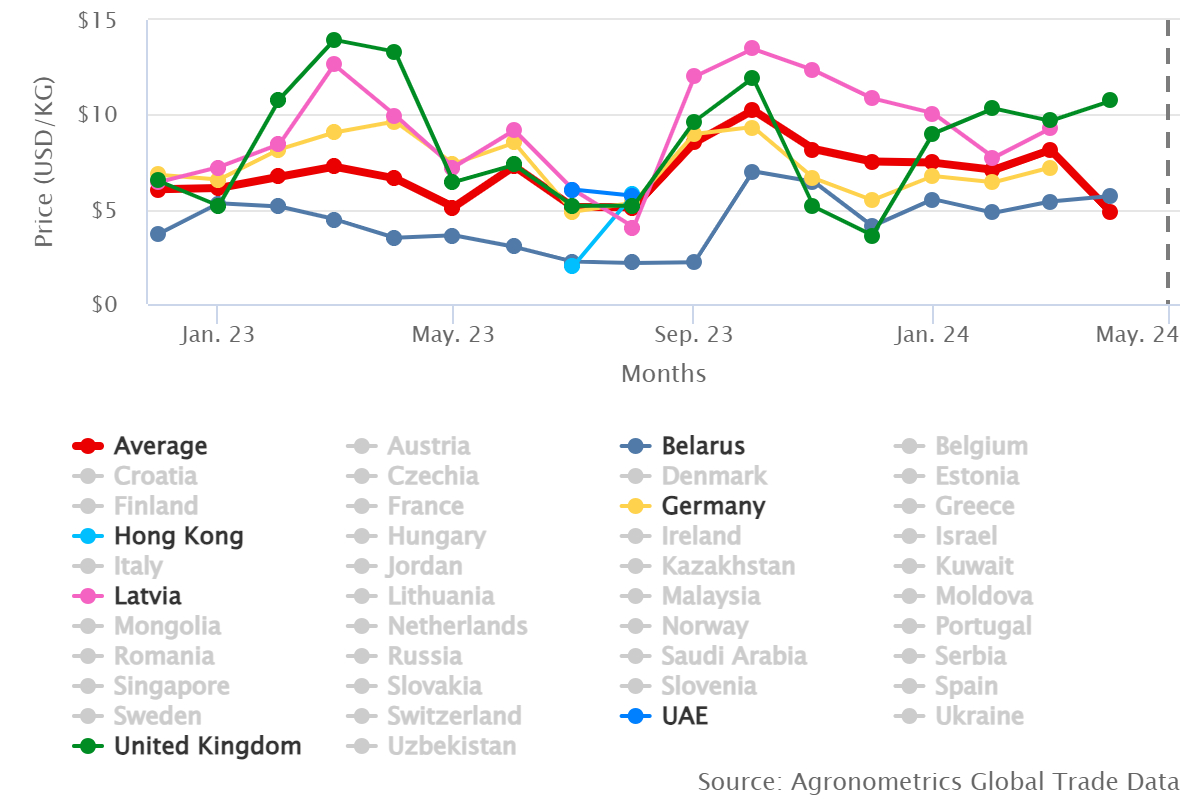
The reason prices in Germany tend to be more stable than in Poland is that German supermarkets are generally more inclined to establish long-term programs. In contrast, Polish supermarkets typically make purchases on a week-to-week basis. As a result, the buying prices in Germany are more consistent but can be lower.
We are also in the process of concluding a protocol with the Chinese market. Currently, audits are being conducted on plantations and packing facilities in Poland. However, it’s still uncertain whether the first Polish blueberries will be exported to China this year, as a final audit for our facility is scheduled for mid-July. This timeline is quite tight, so we are feeling a bit pressed for time. China is a highly demanding market when it comes to quality, so we will have to see if our blueberries meet their stringent requirements.
What do you think are the competitive advantages of Polish blueberries for the export market?
The advantages of Polish blueberries lie in their timing, quality, location, and proximity to the market.
Our location is a significant advantage, especially when considering the German or UK markets. Competitors like Romania and Ukraine often cannot match our delivery times. Those one, two, or three days of difference in transit are crucial, as customers frequently make last-minute decisions and place orders at the last moment. In many cases, we win because we can meet these tight deadlines, whereas other suppliers cannot. Additionally, our large local market is another strength.
Middle Eastern customers often mention that our blueberries taste better compared to those from Zimbabwe, another competitor in this production window. While taste is subjective, it seems to be a favorable point for our product.
Overall, Poland is a major producer of blueberries. As with any large production country, you will find a range of quality. Some producers offer very average products, while others provide top-tier, premium blueberries. Just like in Spain, buyers can find a suitable supplier for their needs, whether they’re looking for standard products for supermarket promotions or something special for premium customers.
As a company trading blueberries year-round, who are your main import partners?
Our main partners for imports are Peru, South Africa, and Chile. While we also import from Spain, we are a relatively new company. The relationships between Spanish exporters and Polish supermarkets are well-established, leaving limited opportunities for us in that space.
However, we also import quite a bit from Serbia and Georgia, essentially sourcing from any country that is not in direct competition with Poland during our growing season. This timing allows us to meet demand without clashing with local production.
Poland Fresh Import Volume By Partner | Cultivated Conventional
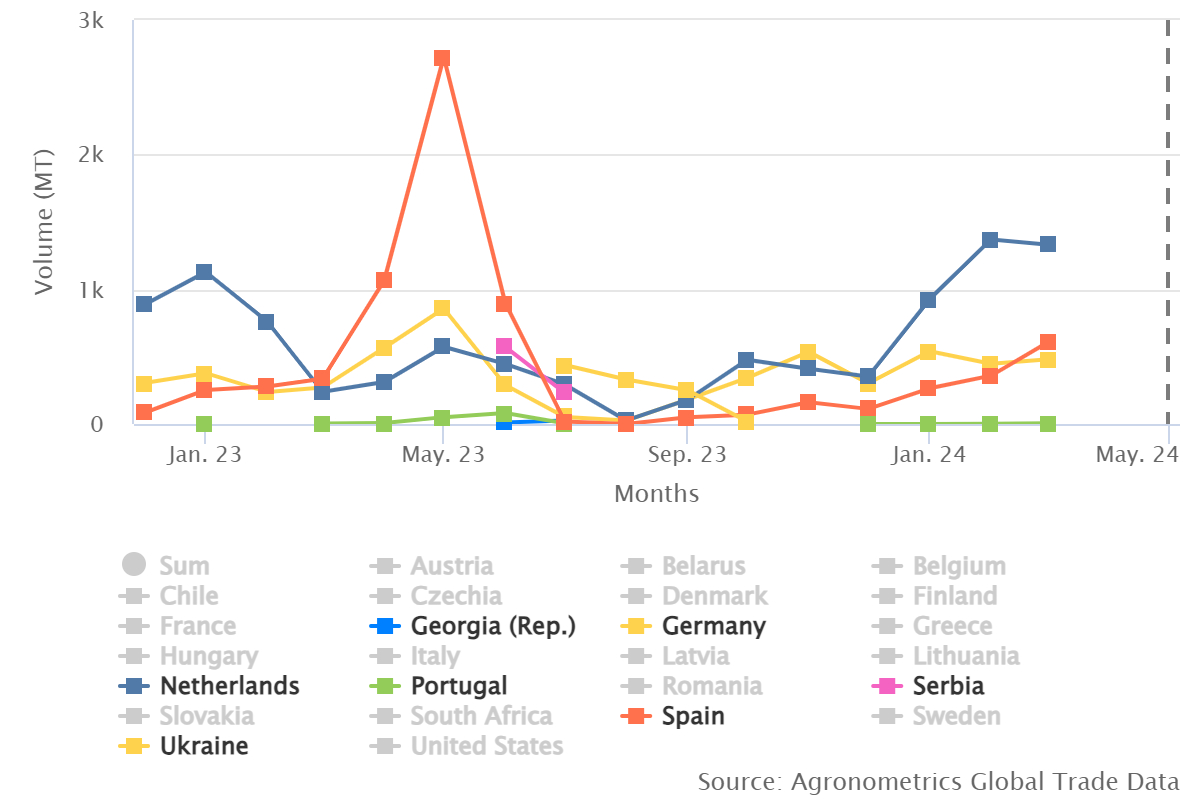
I believe our greatest opportunities lie with more distant overseas suppliers. These partnerships provide a more significant potential for growth and expansion for our company.
In our ‘Interviews’ series, we work to tell impactful stories by collaborating with leaders in the industry. Feel free to take a look at the other articles by clicking here.
All pricing for domestic US produce represents the spot market at Shipping Point (i.e. packing house/climate controlled warehouse, etc.). For imported fruit, the pricing data represents the spot market at Port of Entry.
You can keep track of the markets daily through Agronometrics, a data visualization tool built to help the industry make sense of the huge amounts of data that professionals need to access to make informed decisions. If you found the information and the charts from this article useful, feel free to visit us at www.agronometrics.com where you can easily access these same graphs, or explore the other 21 commodities we currently track.
Written by Thomas



